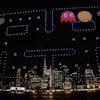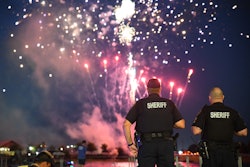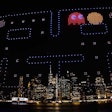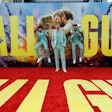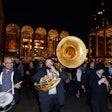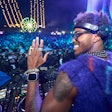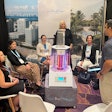
Twenty-three-year-old Madison Dubiski loved the color pink. By the time she graduated high school, she'd spent more than 500 hours volunteering in the areas of childhood cancer and special needs. According to her dad, Brian, “When she talked to you, you felt like you were the most important person in the room."
On Nov. 5, 2021, Madison and nine other attendees were killed in a fatal crowd crush during the Astroworld Festival in Houston, which also injured more than 300 people.
The tragedy sparked her parents, Brian and Michelle Dubiski, to launch the Pink Bows Foundation in her honor. "When tragedy happens, you feel helpless. You’re in a dark place just trying to find some light—and we knew what we could control was how we honored her," Brian Dubiski told BizBash. He was struck by the stats: Since 1996, over 175 people have lost their lives at U.S. concerts, with over 722 deaths reported globally due to event-related crowd incidents—82% of which were caused by preventable hazards.
Dubiski was determined to work with the world's most preeminent safety experts to develop a global standard for crowd safety. He connected with Dr. Mark Hamilton—former head of the International Centre for Crowd Management and Security Studies at Buckinghamshire New University, who has spent more than 30 years as security director for Paul McCartney’s world tours—as well as Steve Allen, CEO of U.K.-based company Crowd Safety, who developed something called the Showstop Procedure in 1998 while touring with the band Oasis at the peak of their fame.
“Oasis fans were so incredibly energetic and dynamic, to the point the U.K. police used to train for what they called the ‘Oasis crowd,'” Allen told BizBash. “It dawned on me there was a great need for there to be a procedure to handle the foreseeable safety-related incidents. I spoke to the band, Noel and Liam [Gallagher], and said, ‘I want to have a system in place where if I tell you to stop the show, you stop it.’ They immediately understood.”
Throughout his career touring with major acts like Led Zeppelin, Eminem, the Dixie Chicks, and the Red Hot Chili Peppers, Allen has stopped 32 shows. Reasons have ranged from crowd-related issues to fire and temporary structural collapse. “The key with this is every second counts," he says. "We haven’t got time to have a powwow with the heads of the department to find out who has the authority to stop the show during an emergency. It has to be instantaneous.”
Allen is now working with Hamilton and the Pink Bows Foundation to bring the Showstop Procedure worldwide. "We thought, ‘How can we work hand in hand with the biggest promoters and venues and artists and city and county officials to really standardize a global process where people are educated and trained to have a better understanding?'" explains Dubiski.
The Pink Bows Foundation will kick off the inaugural Showstop Procedure training and certification on March 26 in Houston; additional courses are set to be announced later this year.
The program has two main components. Anyone can attend a training session, which Allen sees as ideal for event organizers, venue managers, local authorities, law enforcement, and anyone else involved in large-scale events. After that, there’s the professional certificate in Showstop Procedure; those who attend must demonstrate their experience in advance and have an applicant reference. The trainers monitor the applicant throughout an entire event to see how they do, and it's followed by a 75-minute formal exam. “If they pass all that, we’ll endorse them," Allen says.
According to Allen, the key to the Showstop Procedure is having someone who has been trained well in advance—someone who knows what to look for and who isn’t going to be thinking about the financial or PR consequences of stopping a show temporarily. This person needs to have the ultimate executive authority to tell the artist representative to immediately instruct the artist to stop performing and make any necessary announcements to the audience, directly from the stage.
This isn't a dual head of security role or an add-on for someone who already has a full-time job, he adds. “This is someone who will do loads of pre-event research on the artist, the crowd profile, the venue, all historical information. They’ll work to build up rapport with the artist representative during the advance planning stages to determine any sticking points,” he says.
During the show, Allen adds, this person typically is on the side of the stage next to the artist representative (who should be a trusted aid of the artist) wearing noise-canceling headsets, and is devoted solely to looking for any threats: crowd density, active shooter, incoming lighting, a gas leak, etc. The control room will be able to communicate directly with this person on any situation, and give instructions for incidents that may not be visible to the Showstop manager.
“The Showstop Procedure is, of course, not the end-all, be-all—every event should have risk assessments, crowd management plans, event safety plans, all pulled together by competent individuals well-versed in that specific type of event,” Allen adds. “Think of the Showstop Procedure as an emergency stop when driving a car."
The Pink Bows Foundation is backed by industry groups like Event Safety Alliance, Event Safety Alliance Canada, Global Crowd Management Alliance, and the United Kingdom Crowd Management Association; it even has a support from Paul McCartney. The team recently hosted a presentation on the Showstop Procedure at the International Live Music Conference, held in London in late February, and was encouraged to find overwhelming support from the crowd.
“We want this to be a collaborative effort where the entire industry is working together to make a better experience and formalized training so hopefully, no one else loses their child or loved one,” says Dubiski.
Allen stresses that formal training like this is even more important post-pandemic, when so many experienced event organizers and vendors have left the industry. For all event professionals, he suggests taking another look at your event contractors: “What training have they received?" he asks. "Do you have a competent crowd safety manager, who is confident enough to turn around and say, ‘No, that’s not safe’? Can they communicate effectively?”
Start safety conversations from the very beginning of the planning process, Allen adds. “It’s an intrinsic part of everything. A safe show is a successful show—it’s more important than profits, and there is insurance coverage available."
Beyond crowd safety, Pink Bows Foundation raises funds for causes Madison was passionate about; the team has also established Pink Bows Safe Spaces, custom-built pink tents that give event attendees a space to take a break from the crowd if they're feeling anxious or overwhelmed. They are stocked with comfortable furniture and mental health advocates. "The goal is to give attendees a better, safer environment for every aspect of a large event," says Dubiski.
The morning after Madison's death, her cousin went to the site of the Astroworld Festival and left a big pink bow on the fence, a nod to Madison's favorite color. Soon, her parents noticed, the bows started popping up across Houston, and then Dallas, and then New York, Los Angeles, and even the U.K.
“My biggest hope is that there is somehow a light at the end of this darkness that gives my daughter a voice and a legacy,” says Dubiski. “I believe in my heart that what we’re doing would be important to her, and that she’s looking down on us and applauding us for trying to change lives. Hopefully, she would be proud."
Stay updated on the Pink Bows Foundation's work at pinkbowsfoundation.org.

